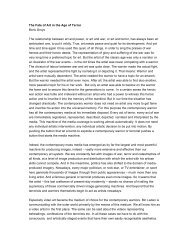Branimir Stojanovic The Case of a Belgrade Monument Dedicated to ...
Branimir Stojanovic The Case of a Belgrade Monument Dedicated to ...
Branimir Stojanovic The Case of a Belgrade Monument Dedicated to ...
Create successful ePaper yourself
Turn your PDF publications into a flip-book with our unique Google optimized e-Paper software.
<strong>Branimir</strong> <strong>S<strong>to</strong>janovic</strong><br />
<strong>The</strong> <strong>Case</strong> <strong>of</strong> a <strong>Belgrade</strong> <strong>Monument</strong> <strong>Dedicated</strong> <strong>to</strong> the Victims <strong>of</strong> Wars in Ex-<br />
Yugoslavia<br />
Sacrificing the Victim<br />
<strong>The</strong> ideological mechanism <strong>of</strong> the joke – there are no cannibals left in our village, we ate<br />
the last one yesterday evening – is probably the best illustration <strong>of</strong> the state <strong>of</strong> those<br />
contemporary European societies who have abandoned the Law and now regulate their<br />
mutual relationships by the norm. Unlike the Law, which had its interior, exterior and<br />
margin, the norm does neither have the interior, neither the exterior, and the subject is in<br />
the situation never <strong>to</strong> be inside and never <strong>to</strong> be outside the norm, like in the case <strong>of</strong> the<br />
joke about the cannibal, which lacks both exterior and interior. Everyone can eat<br />
cannibals and be eaten as a cannibal, without breaching the prohibition <strong>to</strong> eat people,<br />
because he who eats cannibals does not eat people.<br />
Since the cannibal joke sees no connection between eating people and cannibalism,<br />
eating people becomes a legalized institution <strong>of</strong> the community, in which from now on it<br />
is possible <strong>to</strong> eat people without breaching the prohibition <strong>to</strong> eat people.<br />
However, it is clear that this mechanism allows for an unimpeded ideological<br />
reproduction <strong>of</strong> the cannibalistic society, in fact a meta-cannibalistic society, because he<br />
who eats the cannibal also eats the prohibition <strong>to</strong> eat people.<br />
In other words, the norm has now taken the place <strong>of</strong> the Law, and the Law against eating<br />
people is no longer in effect, and the norm <strong>of</strong> the cannibal joke has come in<strong>to</strong> effect<br />
instead, giving rise <strong>to</strong> the conflict between those who eat cannibals and those who eat<br />
people.<br />
<strong>The</strong> paradox <strong>of</strong> the society <strong>of</strong> the norm is in fact that <strong>of</strong> pre-his<strong>to</strong>rical societies which had<br />
their vehement onset during the mid 1970’s, after the death <strong>of</strong> the 20th century’s ultimate<br />
political emancipating subject – Cultural Revolution. However, what becomes the crucial<br />
issue <strong>of</strong> the post-his<strong>to</strong>rical age, the age <strong>of</strong> the norm, is the problem <strong>of</strong> memory. <strong>The</strong> posthis<strong>to</strong>rical<br />
subject, not the political subject par excellence, is completely void <strong>of</strong> all<br />
memory and de-centered in a paradoxical fashion: at once, he has full recollection <strong>of</strong><br />
everything, is unable <strong>to</strong> forget, but fails <strong>to</strong> attach any memory <strong>to</strong> himself. <strong>The</strong> object that<br />
is part <strong>of</strong> the post-his<strong>to</strong>rical subject’s memory must meet two important criteria: be<br />
completely destroyed in reality and be erased without trace from the records <strong>of</strong> the<br />
symbolic.<br />
So, the <strong>Monument</strong>, an object <strong>of</strong> public memory in the post-his<strong>to</strong>rical age, becomes an<br />
impossible object. And if it indeed exists, it commemorates oblivion rather than<br />
remembrance. Rather, it is an object that threatens, and not an object that we can calmly
est our gaze upon and see it as a screen <strong>of</strong> memory hiding the trauma that it is supposed<br />
<strong>to</strong> commemorate. <strong>The</strong> monument has become the trauma for itself and by itself.<br />
What then is the only possible monument <strong>of</strong> the post-his<strong>to</strong>ric age <strong>The</strong> only possible<br />
object <strong>of</strong> public memory worthy <strong>of</strong> a monument in the post-his<strong>to</strong>ric age is the Victim. But<br />
what is the Victim In order <strong>to</strong> meet the standard <strong>of</strong> a monument-worthy victim, it has <strong>to</strong><br />
be a victim <strong>of</strong> radical Evil, as it is exemplified by the Holocaust.<br />
<strong>The</strong> monument erected central Berlin – called the ‘<strong>Monument</strong> <strong>to</strong> the Murdered Jews <strong>of</strong><br />
Europe’ – is a prime example <strong>of</strong> a post-his<strong>to</strong>rical monument. <strong>The</strong> performative force <strong>of</strong><br />
this monument is reduced <strong>to</strong> a connotation that erases all his<strong>to</strong>rical reality, especially the<br />
reality that created the conditions for the holocaust itself. <strong>The</strong> monument brings <strong>to</strong> mind<br />
the sentence ‘a child was beaten’, which Freud so brilliantly analyzed for us. <strong>The</strong> place<br />
<strong>of</strong> the enunciation, the mark <strong>of</strong> inscribing the subject <strong>of</strong> the enunciation, disappears<br />
completely in the content <strong>of</strong> the statement. Also, we do not know who is beating the<br />
child, we do not know when or where the child has been beaten.<br />
And we don’t know who is making the statement. Does it come from a witness <strong>to</strong> the<br />
beating Is it made by who is being beaten Or is it made by who is beating the child<br />
In other words, we are in a world without borders, a world without subject and object; a<br />
post-his<strong>to</strong>rical world in which the Victim, in order <strong>to</strong> be the object worthy <strong>of</strong><br />
remembrance, must be utterly destroyed in reality and <strong>to</strong>tally erased symbolically,<br />
inaccessible <strong>to</strong> any remembrance whatsoever.<br />
<strong>The</strong> <strong>Belgrade</strong> monument<br />
<strong>The</strong> case <strong>of</strong> the <strong>Belgrade</strong> monument is a failed attempt at making a post-his<strong>to</strong>rical<br />
monument dedicated <strong>to</strong> the Victim. Because <strong>of</strong> its failure, it provides a conceptual<br />
framework for a more general analysis <strong>of</strong> monuments dedicated <strong>to</strong> the Victim, the central<br />
object <strong>of</strong> post-his<strong>to</strong>rical societies.<br />
<strong>The</strong> original intention <strong>of</strong> the <strong>Belgrade</strong> city authorities was <strong>to</strong> make a monument <strong>to</strong> the<br />
Victim after ten years <strong>of</strong> killing in the terri<strong>to</strong>ry <strong>of</strong> former Yugoslavia, in order <strong>to</strong> distance<br />
themselves from the decade-long bloody drama, the architect <strong>of</strong> which was the<br />
government they were the successor <strong>of</strong>.<br />
<strong>The</strong> intention behind erecting a monument <strong>to</strong> a victim is lost, as soon as the victim<br />
becomes linked <strong>to</strong> a war. In this way, the authorities that announced the competition<br />
missed the epochal conceptual framework <strong>of</strong> the Victim. By linking the Victim <strong>to</strong> the<br />
War the jury stated that it is not dedicating the monument <strong>to</strong> Victim, because the Victim<br />
is a Victim only if <strong>to</strong>tally destroyed. War is not the same as <strong>to</strong>tal destruction. War is a<br />
his<strong>to</strong>rical event.<br />
<strong>The</strong> commission that was mandated <strong>to</strong> announce the competition was named the<br />
‘Commission for the competition for the monument dedicated <strong>to</strong> the victims <strong>of</strong> the wars in
Ex Yugoslavia, 1990-1999’. This very name points at a difference between Victim in the<br />
singular, and Victim in the plural sense. <strong>The</strong> plural Victim <strong>of</strong> war has been subjected <strong>to</strong><br />
heterogeneous atrocities: mass murder, ethnic cleansing, the siege <strong>of</strong> cities, rape, killing<br />
<strong>of</strong> women, children and elderly people. On the other side, there is endless differentiation<br />
<strong>of</strong> one state subject and its army in<strong>to</strong> an unstable multitude <strong>of</strong> states <strong>of</strong> military and<br />
paramilitary formations responsible for all those mass and individual killings.<br />
If we say Victim, this is meant as beyond world and time. Introducing place and time <strong>to</strong><br />
the monument for the Victim, means in fact introducing his<strong>to</strong>rical time <strong>to</strong> the posthis<strong>to</strong>rical<br />
object. It tells us that this competition, behind its absolutely heterogeneous<br />
multitude <strong>of</strong> victims, hides in fact a certain victim that the organizer <strong>of</strong> the competition<br />
had in mind, but failed <strong>to</strong> name.<br />
<strong>The</strong> title <strong>of</strong> the competition was re-stated, and dedicated <strong>to</strong> the ‘Memory <strong>of</strong> the victims <strong>of</strong><br />
the wars in ex-Yugoslavia and the victims <strong>of</strong> the 1999 NATO bombing’. Apart from the<br />
victims <strong>of</strong> the wars in ex-Yugoslavia, another two mysterious entities appear: the fallen<br />
fighter and the victim <strong>of</strong> the NATO bombing. <strong>The</strong> initial intention <strong>to</strong> have a monument<br />
dedicated <strong>to</strong> all the victims now suddenly becomes its opposite, since all the victims, the<br />
multitude <strong>of</strong> people killed, are reduced <strong>to</strong> just two entities – fallen fighters and victims <strong>of</strong><br />
the NATO bombing. So the monument is dedicated <strong>to</strong> an inconsistent multitude: the<br />
victims <strong>of</strong> the wars in ex-Yugoslavia and the victim <strong>of</strong> the NATO bombing, who were<br />
not the victims <strong>of</strong> the wars in ex-Yugoslavia but rather the victims <strong>of</strong> a humanitarian war<br />
operation <strong>of</strong> a military alliance outside the terri<strong>to</strong>ry <strong>of</strong> the former Yugoslavia. In addition,<br />
the fallen fighters and victims <strong>of</strong> the NATO bombing are only Serbian victims, and the<br />
multitude <strong>of</strong> ethnic and national entities killed in the events in ex-Yugoslavia is excluded<br />
in order <strong>to</strong> circumscribe just one national group. Adding <strong>to</strong> the confusion is the fact that<br />
the fallen fighter is the syntagma used <strong>to</strong> identify the fallen members <strong>of</strong> the National<br />
Liberation Movement, i.e. the fighters who, during the Second World War, defeated<br />
National Socialism in the terri<strong>to</strong>ry <strong>of</strong> former Yugoslavia. In fact, his<strong>to</strong>rically, the<br />
denomination ‘fallen fighters’ applies exclusively <strong>to</strong> them. So, the initial intent <strong>to</strong> make a<br />
post-his<strong>to</strong>rical monument <strong>to</strong> the Victim turned in<strong>to</strong> its complete opposite, in<strong>to</strong> an<br />
amalgamate <strong>of</strong> various entities: those who are, his<strong>to</strong>rically, fifty years apart, complete<br />
opposites, i.e. belonging <strong>to</strong> entirely different contexts.<br />
If the organizer <strong>of</strong> the competition had wanted <strong>to</strong> remain faithful <strong>to</strong> his initial intention <strong>to</strong><br />
make a monument <strong>to</strong> the Victim, the monument’s name would have <strong>to</strong> be ‘<strong>Monument</strong> <strong>to</strong><br />
the Victim’, because any other name carries the contradictions that the wars in ex-<br />
Yugoslavia were infested by.<br />
<strong>The</strong> impossibility <strong>to</strong> dedicate a monument <strong>to</strong> the victims <strong>of</strong> the wars in ex-Yugoslavia<br />
challenges the very possibility <strong>of</strong> erecting a monument in general, since any other<br />
definition <strong>of</strong> the monument would produce the conflict <strong>to</strong> which it should be dedicated.
<strong>The</strong> case <strong>of</strong> the <strong>Belgrade</strong> monument, instead <strong>of</strong> the <strong>Monument</strong> <strong>to</strong> the Victim, became the<br />
monument <strong>to</strong> sacrificing the victim, a naïve attempt <strong>to</strong> place a post-his<strong>to</strong>rical monument<br />
in the context <strong>of</strong> his<strong>to</strong>rical events. Hence, the <strong>Belgrade</strong> monument raises the more general<br />
question <strong>of</strong> the monument in the post-his<strong>to</strong>rical age; it points at the impossibility <strong>of</strong> the<br />
existence <strong>of</strong> the <strong>Monument</strong> as the object <strong>of</strong> public memory.<br />
2002-2007, <strong>Belgrade</strong>













